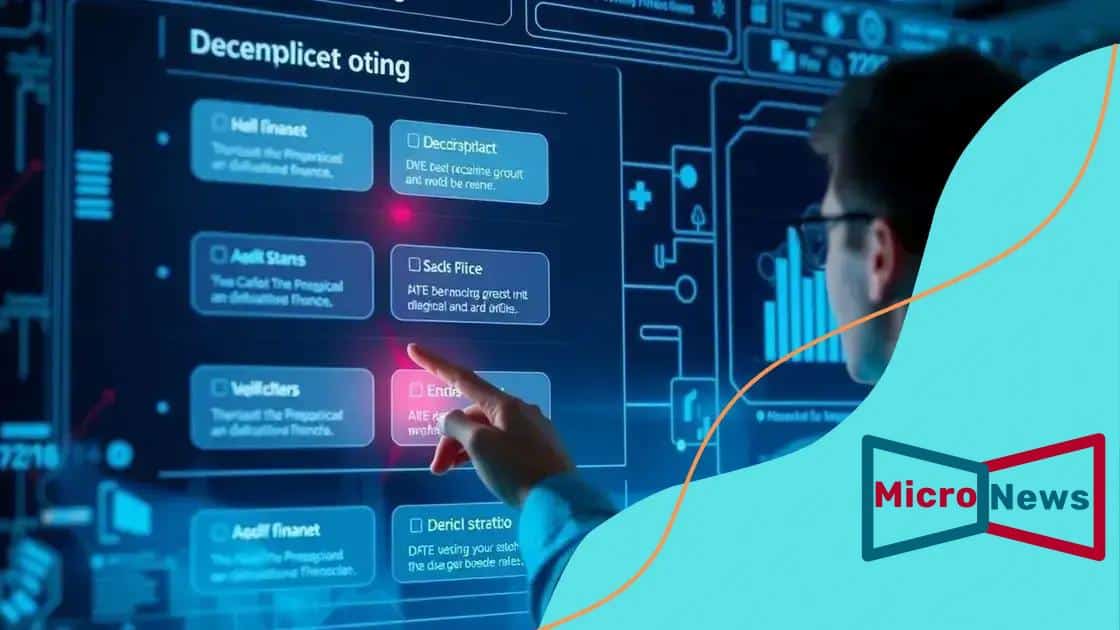Decentralized finance (DeFi) and its rise in popularity

Decentralized finance (DeFi) revolutionizes finance by offering accessible, low-cost, and user-controlled financial services, while facing challenges such as security risks and regulatory uncertainty, alongside promising future trends like interoperability and improved user experiences.
Decentralized finance (DeFi) is changing the way we think about money and banking. Have you ever wondered how this revolution can impact your financial choices? In this article, we’ll dive into what DeFi means and why it’s gaining traction.
Understanding decentralized finance (DeFi)
Understanding decentralized finance (DeFi) is crucial for anyone interested in the future of finance. This innovative approach offers a new way to manage money and access a variety of financial services without relying on traditional banks.
DeFi utilizes blockchain technology to provide users with more control over their assets. This means you can lend, borrow, and trade cryptocurrencies on decentralized platforms. The beauty of DeFi lies in its autonomy and accessibility.
Key Features of DeFi
Some primary characteristics of DeFi platforms include:
- Smart contracts: These are self-executing contracts with the terms of the agreement directly written into lines of code.
- Open-source: Most DeFi projects are open-source, promoting transparency and collaboration.
- User control: Users maintain control of their private keys and funds without intermediaries.
Understanding how DeFi operates helps users navigate its complexities. Users engage with platforms that allow them to invest and earn interest without conventional banking restrictions. Often, these platforms use stablecoins to minimize volatility and provide a more stable investment environment.
Moreover, decentralized exchanges (DEXs) enable users to trade assets without a central authority. This enhances security and reduces the risk of hacks that plague centralized exchanges. The appeal of DeFi lies not only in its innovative technology but also in its potential to reshape financial systems globally.
Benefits of Using DeFi
Engaging with DeFi provides several advantages:
- Accessibility: Anyone with an internet connection can access DeFi services, regardless of their location.
- Lower fees: DeFi platforms typically have lower transaction fees compared to traditional financial services.
- Greater earning potential: Individuals can earn higher returns on investments and interest rates in DeFi.
In conclusion, as we delve deeper into decentralized finance (DeFi), it’s clear that it has the potential to revolutionize finance by offering transparency, security, and access to everyone.
Key components of DeFi
When exploring decentralized finance (DeFi), it’s essential to understand its key components. These elements work together to create a robust ecosystem that empowers users with financial freedom and control.
At the core of DeFi are smart contracts. These are automated agreements that execute actions on the blockchain when specified conditions are met. By eliminating intermediaries, smart contracts increase efficiency and reduce costs.
Decentralized Applications (DApps)
DApps provide user interfaces for interacting with DeFi services. They allow users to trade, lend, and borrow without going through traditional banks. These applications are built on top of blockchain networks like Ethereum, where developers can create various financial services.
- Security: DApps are usually secure due to the transparency of blockchain technology.
- Interoperability: Many DApps can work together, allowing users to switch services seamlessly.
- User-centric: DApps often prioritize user experience, making financial tasks easy to complete.
Another critical component of DeFi is liquidity pools. These pools hold funds that enable decentralized trading and lending. Users can contribute their tokens to these pools and earn interest or trading fees in return.
Token Standards
Token standards like ERC-20 and ERC-721 also play a vital role in the DeFi landscape. These standards define how tokens are created and interact with DApps. Understanding these standards helps users comprehend the functionality and limitations of various tokens.
In conclusion, each component of DeFi contributes to the overall ecosystem, providing users with innovative financial tools and services. By grasping these key elements, users can make informed decisions and navigate the DeFi space effectively.
Benefits of using DeFi

Using decentralized finance (DeFi) comes with numerous benefits that can enhance how individuals manage their financial activities. As traditional finance systems evolve, DeFi presents unique advantages that make it appealing to users around the world.
One of the most significant benefits is accessibility. Anyone with an internet connection can participate in DeFi platforms, regardless of geographic location or economic background. This democratization of finance is a game changer.
Lower Costs
Another advantage is the potential for lower fees. DeFi transactions often incur fees that are significantly lower than those charged by traditional banks. Users can save more of their money for investments or savings.
- No intermediaries: By eliminating middlemen, users often avoid extra charges for services.
- Competitive rates: DeFi platforms frequently offer better interest rates than conventional banks.
- Instant transactions: Transactions can be processed much faster in DeFi, reducing waiting times.
Furthermore, DeFi provides enhanced transparency. All transactions are recorded on the blockchain, making them publicly accessible and verifiable. This reduces the likelihood of fraud or manipulation.
Potential for Higher Returns
Investing in DeFi can also yield higher returns compared to traditional investments. Users can earn interest on their deposits or participate in liquidity pools for trading, often receiving better rewards than they would in standard savings accounts.
It’s important to consider innovation in financial services as well. DeFi encourages new financial products, giving users opportunities to engage in lending, borrowing, and trading that were not previously available. This opens up pathways for creativity in personal finance.
Lastly, DeFi fosters greater control over personal finances. Users hold their private keys and maintain ownership of their assets without reliance on third-party institutions. This shift empowers individuals to manage their wealth directly, enhancing their financial independence.
Challenges faced by DeFi platforms
While decentralized finance (DeFi) offers many advantages, several challenges must be addressed for its continued growth and acceptance. Understanding these challenges is crucial for users and developers alike.
One major issue is security risks. DeFi platforms are often targeted by hackers and malicious actors. Even small vulnerabilities in smart contracts can lead to significant losses for users. Therefore, ensuring security through audits and constant updates is essential.
Regulatory Uncertainty
Another challenge is the regulatory landscape. Many governments are still figuring out how to regulate DeFi, leading to uncertainty. This can create hesitance among investors and developers who may worry about future restrictions or compliance issues.
- Legal implications: Unclear regulations can expose users to legal risks.
- Market manipulation: Inconsistent regulations can result in unfair practices.
- Consumer protection: Lack of oversight may leave users vulnerable to scams.
Moreover, the complexity of use can deter new users. The technical knowledge required to interact with DeFi platforms might overwhelm beginners. Simple interfaces and educational resources are vital to attract a broader audience.
Scalability Issues
Scalability is another significant concern. As more users join DeFi platforms, the demand on the blockchain network increases. This can lead to higher transaction fees and slower processing times, undermining the benefits of using DeFi.
Finally, liquidity concerns also pose challenges. Some DeFi projects struggle to maintain adequate liquidity, making it difficult for users to execute trades or withdraw funds. Ensuring sufficient liquidity is crucial for a seamless user experience.
Future trends in DeFi
The future of decentralized finance (DeFi) is bright, with many potential trends shaping its progress. As the technology develops, users can expect innovative changes that influence how finance works.
One upcoming trend is increased interoperability. This means different blockchain networks will work together more effectively. Improved interoperability will allow users to transfer assets across various platforms easily, enhancing the overall DeFi experience.
Integration with Traditional Finance
As DeFi continues to grow, its integration with traditional finance will become more apparent. Traditional financial institutions may adopt DeFi principles to improve their services. This collaboration could lead to more efficient banking systems that benefit from the transparency and lower costs of DeFi.
- Collaboration: Banks may partner with DeFi platforms to offer users better options.
- Hybrid models: New financial products could emerge, combining classic finance with DeFi features.
- Regulatory engagement: Traditional finance’s influence may lead to clearer regulations for DeFi.
Another trend to watch is the development of layer-two scaling solutions. These solutions improve transaction speeds and lower fees for DeFi applications. As user demand grows, efficient layers can help prevent congestion on primary blockchains.
Focus on User Experience
There will also be a stronger emphasis on user experience (UX). DeFi platforms are likely to improve their interfaces to make them more user-friendly. This focus will attract newcomers who may feel overwhelmed by the current complexity.
As the industry matures, security standards will also improve. Developers will focus on creating safer protocols, protecting users from potential hacks and breaches. Trust is vital in encouraging more people to participate in DeFi.
In summary, the future trends in DeFi indicate a dynamic transformation that embraces innovation while addressing current challenges. As this space evolves, more individuals will have access to diverse and efficient financial services.
FAQ – Frequently Asked Questions about Decentralized Finance (DeFi)
What are the main benefits of using DeFi?
The main benefits include accessibility for everyone, lower transaction fees, and greater control over assets.
What security risks do DeFi platforms face?
DeFi platforms are vulnerable to hacks and smart contract vulnerabilities, which can lead to significant losses for users.
How does DeFi integrate with traditional finance?
DeFi can collaborate with traditional finance by offering better services and creating hybrid financial products that leverage both systems.
What future trends should we expect in DeFi?
Expect improvements in interoperability between platforms, enhanced user experience, and stricter security standards.





